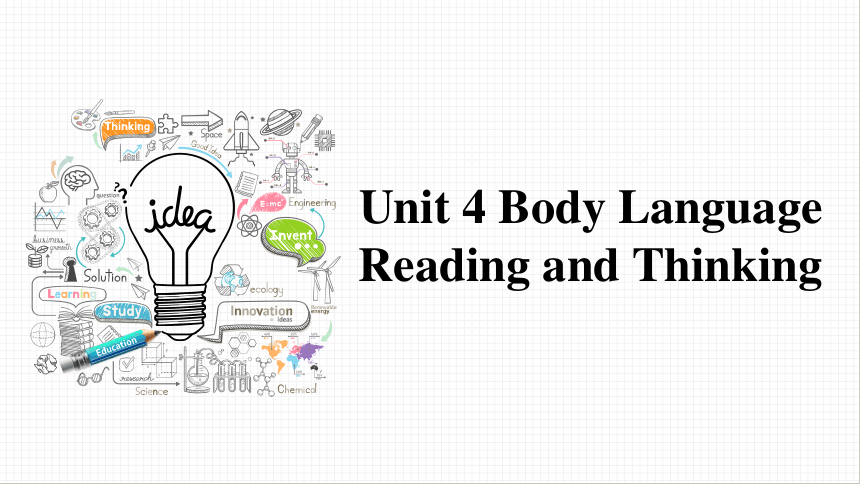(
课件网) Unit 4 Body Language Reading and Thinking By the end of this class, you will be able to: 1. get a better understanding of body language by grasping the main points of the passage. 2. develop the ability to identify the topic sentence in a para and figure out the structure of a passage. 3. develop a sense of cross-cultural communication by identifying the feature of body language. Learning objectives What I hide by my language, my body utters. —Roland Barthes NO!!! Are you mad at me Watch and Think. What does the speaker talk about in the video Lead-in Can you get their emotions through this picture Why Forms of non-verbal communication 非语言的沟通形式 Body Language What is Body Language Eye contact 眼神交流 Facial expressions 面部表情 Gestures 手势 Postures 姿势 Prediction Look at the title and the picture, the passage may be about _____. how body language expresses our feelings, thoughts and opinions The type of the passage is _____. an exposition (说明文) Pre-reading Choose five sentences and act them out without speaking. Can your partner guess what you are trying to communicate Example: Para.1 Para.2 Para.3 Para.4 Para.5 Para.6 Body language plays an important role in daily communication. Just like spoken language, body language varies from culture to culture. The gesture for "Ok” has different meanings in different cultures. Even the gestures we use for "yes "and "no" differ around the world. Some gestures seem to have the same meaning everywhere. Some body language has many different uses. While-reading Read for main idea Para.1 Para.2 Para.3 Para.4 Para.5 Para.6 Introduction The differences The similarities Different Uses Read for structure Part 1 (Para1) Introduction to body language Part 2 (Para2-4) Part 3 (Para 5) Part 4 (Para 6) The differences The similarities Different uses 总 分 Read for structure n. 一起活动, 合作 What is the function of the last sentence in Paragraph 1 It is both a topic sentence(主题句)and a transitional sentence(过渡句). Read for details Para.1 v. 变化 adj. 适当的,恰当的 v. 核准;认可 Body language Meaning Country/Region Eye contact between men and women Looking down when talking to someone topic sentence Not polite Middle East a sign of respect Japan Para.2 vt. 说明,证明,显示,表露 n. 目击者;证人 vt. 雇用 adj. 同一的 vt. 解释;说明 vt. & vi. 口译;翻译 OK sign Japan France Brazil and Germany Money Zero Not polite topic sentence Para.3 v. 相异;有区别;不同于 n. 面颊,脸颊 vt. 喜爱 v. 弯腰;鞠躬 n. 腰 Make inferences Sometimes a passage does not say something directly. However, you can figure it out by looking at the clues in the passage. What can be inferred from the underline sentences of paragraph 4 In Bulgaria and southern Albania, shaking one’s head means “yes”, and nodding means “no”. topic sentence Para.4 Meaning Country/region sleep most places I’m full Body language/Gesture Placing your hands together and resting them on the s ... ...

